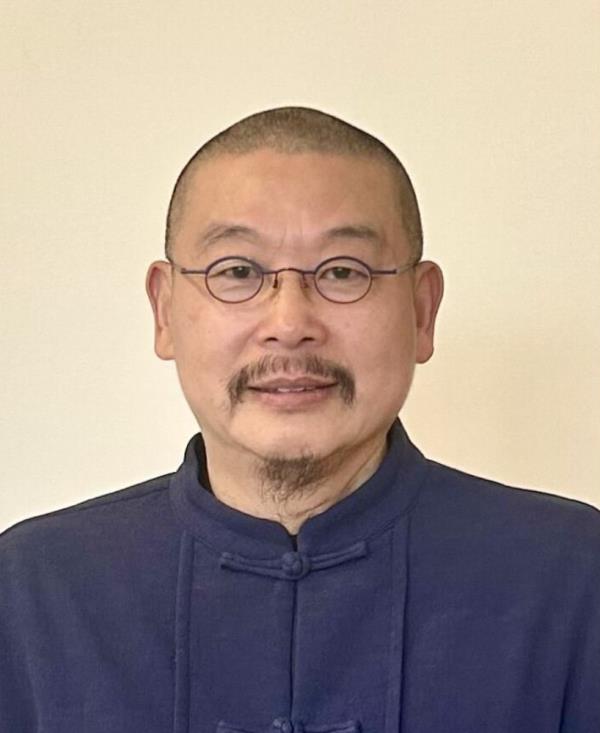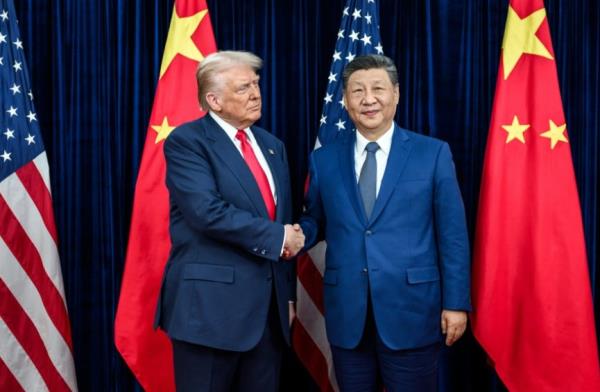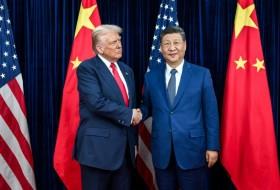
- ▲ 杨建利 哈佛大学肯尼迪政治学院研究员

- ▲ 上月30日,美国总统唐纳德·特朗普在举行双边会谈之前,正在金海国际机场航站楼迎接中国国家主席习近平。/ 合众国际社
两国都意识到了虽然可以针对对方的供应链、市场和技术生态系统进行严重打击,但这样做也会让自己蒙受重大损失的严峻现实。因此,在首脑会谈之前,中国宣布限制稀土出口或特朗普宣布提高100%关税,实际上都不过是虚张声势。会谈前夕,特朗普在空军一号上对记者表示“不会实施加征关税”,中国也将稀土出口限制推迟了一年。
为了阻止芬太尼流入美国,中国决定加强管制,美国决定把针对芬太尼相关中国进口商品征收的20%关税减半。习近平承诺大量采购美国大豆,并暂停中国对美国301条措施的应对行动。美国也承诺停止扩大出口管制,并承诺停止互征港口费。
但双方协议中“验证”的不对称性十分明显。美国做出让步的降低关税、停止征收港口费、推迟出口管制,都是可以衡量且能够确认履行结果的。相反,中国承诺的加强监管、大量采购、停止对等措施的表述模糊,且不易确认执行情况。如果没有可以确认和验证的客观机制,协议很容易被破坏。因此,今后双方不应着眼于各自做出了多少“让步”,而应集中精力设计并建立明确的履行验证机制,以消除争议的隐患。
在习近平战术灵活性的背后,是一贯的构建“不被孤立的要塞”构想的战略。这就是在顶住西方压力的同时,维持能够吸引海外市场、海外资金和技术的全球整合,在主要领域打造完成技术自立的国家。而贸易停火正好符合他的这一战略。
相反,特朗普是从交易的角度出发来处理这次首脑会议的。他执着于关税、就业、即时政治成果等,而非长远的眼光。但美国真正的优势不在于“交易”,而在于团结盟友、建立规范和制度、以及开放的社会道德和制度号召力。如果美国不能正确利用这些优势,那么就只能在中国所希望的“双边谈判”和“力量平衡”这一倾斜的赛场上展开竞争。
这次首脑会谈最令人鼓舞的成果不是“停火协议本身”,而是建立了在每次危机时通过谈判和重新调整来恢复平衡的“机制”。虽然悬而未决的争议(特别是台湾问题)被搁置,但这本身可能是一种明智的选择。先搁置无法解决的问题,从可以处理的问题开始解决,从而减少风险。真正的“大交易”不是一次性的大和解,而是建立一个能够吸收冲击、重新调整平衡的“持续的谈判结构”。对于像美中这样意识形态对立的两个大国,世界所能期待的唯一秩序,不是“永远的敌对关系”,而是“可控的竞争”。
<英语原文>
As I anticipated in my article for The Chosun Ilbo, the much-watched Trump–Xi meeting at APEC in Gyeongju was never meant to deliver a grand bargain that could stabilize and redefine the U.S.–China relationship for decades. Instead, both leaders sought something far more modest yet crucial: a trade truce—a temporary ceasefire in a protracted economic war that neither side can win outright nor afford to lose completely. The agreements reached were designed to buy time, not to resolve the structural contradictions that underlie the world’s most consequential rivalry.
Since President Trump launched his renewed tariff offensive in April after taking office, the two economies have spent seven months in an intense duel of economic coercion—tariffs, export controls, investment bans, and rare-earth restrictions. Through this cycle of action and counteraction, both Washington and Beijing have come to recognize a sobering truth: they are now locked in a form of mutually assured economic destruction. Each possesses the power to inflict great harm on the other’s supply chains, markets, and technology ecosystems, yet neither can do so without severe self-damage. This emerging “strategic balance of interdependence” does not mark the end of competition; rather, it defines a new phase of it. The United States and China have entered an unstable equilibrium—one in which the balance can be easily disturbed, sending the system into dangerous spirals of escalation. Trade, technology, and security are now so deeply intertwined that a tariff adjustment or export restriction can cascade into a diplomatic rupture or regional confrontation.
Before the summit, observers could clearly see that China’s announcement of rare-earth export restrictions to the world and Trump’s subsequent declaration of a 100 percent tariff hike were both bluffs. If the two sides truly intended to reach a trade truce, they would each have to abandon their respective threats. Indeed, just before the summit, Trump admitted to reporters aboard Air Force One that the tariff threat would not be carried out, while China postponed its export restriction plan by one year—which, in practice, means it will not be implemented at all, as there will be many opportunities to negotiate again within that time. These reciprocal retreats before the summit clearly showed that both leaders understood the costs of escalation and the necessity of compromise. The bluffs themselves served a purpose: to project resolve while leaving room for retreat. Once the signaling was done, each side quietly stepped back, opening a narrow window for the truce to be reached.
Against this volatile backdrop, the two sides concluded a limited one-year trade truce, with provisions subject to annual renewal. Beijing pledged to intensify its efforts to curb the flow of synthetic opioids such as fentanyl into the United States. In response, Washington agreed to cut by half the 20-percent tariff imposed on fentanyl-related imports, lowering the average tariff rate on Chinese goods from 57 to 47 percent. President Xi also promised large purchases of American soybeans and a suspension of China’s counter-measures related to Washington’s Section 301 investigations—those targeting subsidies, forced technology transfer, and intellectual property violations. The United States, in turn, agreed to halt the expansion of technology export controls to Chinese subsidiaries and to suspend reciprocal port fees. Both leaders announced reciprocal visits in 2026, with Trump to visit Beijing in April and Xi to travel to Washington “sometime thereafter.”
Yet the asymmetry in verifiability is striking. Every major U.S. concession—tariff reduction, suspension of port fees, delay in export controls—is measurable and enforceable. By contrast, China’s central commitments—“intensify control,” “large purchases,” “suspend counter-measures”—are vague and difficult to verify. Without a credible mechanism for verification and enforcement, the fragile trust between the two sides could quickly erode. This is why future negotiations must focus not merely on new concessions but on creating a verifying mechanism capable of monitoring compliance, reducing ambiguity, and preventing disputes from destabilizing the system.
Beneath Xi Jinping’s tactical flexibility lies a strategic constant: his pursuit of what may be called a “fortress without isolation” grand strategy. Xi aims to build an economy that is resilient, self-sufficient in critical sectors, and shielded from Western coercion—yet still integrated enough to access foreign markets, capital, and technology. The goal is to harden China’s defenses without repeating Mao-era autarky. The trade truce fits neatly into this strategy: it offers breathing space to consolidate supply-chain resilience, attract investment from the Global South, and expand technological partnerships beyond the Western sphere. Trump, by contrast, approached the summit in a more transactional manner. His negotiating instinct focuses on immediate gains—tariffs, jobs, and political optics—rather than constructing a coherent long-term framework. America’s advantage, however, lies not in transactional leverage but in its enduring ability to rally allies, shape rules, and project the moral and institutional appeal of an open society. If Washington fails to activate these systemic advantages, it will fight China on the terrain of Beijing’s choosing—bilateral bargaining and power balancing—where the U.S. edge is limited.
The Gyeongju summit also reminded the world that many key players—especially U.S. allies like South Korea, Japan, and Australia—are watching closely. They see in this fragile truce not peace, but a temporary pause in a contest that will define the region’s strategic architecture. These middle powers prefer stability, yet they also seek autonomy, wary of being forced to choose sides. America’s challenge is to reassure them that alliance with the U.S. means partnership, not entrapment, and that cooperation in building resilient supply chains, AI governance, and energy security is more rewarding than short-term neutrality.
Perhaps the most encouraging outcome of the summit is not the content of the truce itself, but the pattern it established: the notion that the two sides can, when equilibrium is disturbed, find a way back to stability through dialogue and periodic renegotiation. Regular renewal of agreements, however limited, institutionalizes crisis management. It represents an emerging mechanism to prevent the system from spiraling out of control—a way to transform rivalry from a zero-sum confrontation into a managed competition. Both leaders, in effect, postponed the questions they cannot yet answer—above all, Taiwan. Yet that postponement may be an act of wisdom. By deferring the insoluble, they preserved room for maneuver and reduced the risk of confrontation. This mechanism itself may be the grand deal they can possibly find. The real “grand deal” may not be a single sweeping accord, but the creation of a durable process—one that can absorb shocks, reset expectations, and sustain equilibrium amid turbulence.
In this new phase, turbulence will not disappear; it may even become necessary. Each side may occasionally provoke small crises to test the mechanisms of resolution, to ensure that the system still functions. This pattern of “trouble and repair” could paradoxically enhance stability, as long as both sides understand the boundaries of their contest. Managed rivalry, not perpetual hostility, is the closest the world can hope for between two powers so deeply interlocked yet ideologically opposed. The Trump–Xi summit did not end the trade war, nor did it redefine the global order. But it signaled the emergence of a new pragmatism—a shared recognition that stability itself is a strategic asset. Both Washington and Beijing are learning to live with rivalry, to regulate rather than resolve it. If they can institutionalize this pattern of recalibration—equilibrium, disturbance, new equilibrium—they may yet prevent the system from collapsing under its own contradictions. The real test will come when the next crisis hits. But for now, the Gyeongju truce has given the world something rare in the U.S.–China relationship: a breathing space, and perhaps, the first glimpse of a sustainable balance in an age of mutual vulnerability.



.jpg)





.jpg)
.jpg)
.jpg)
.jpg)
.jpg)
